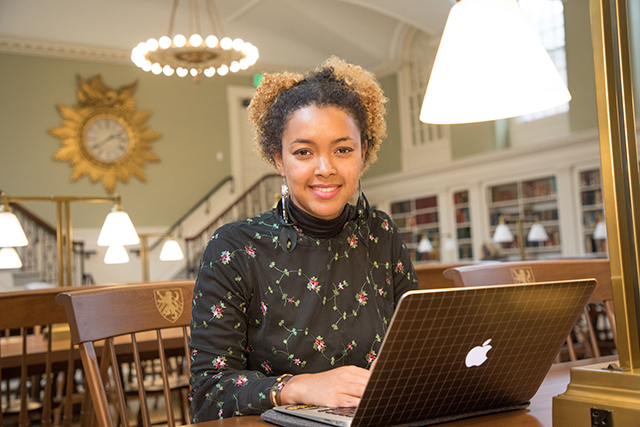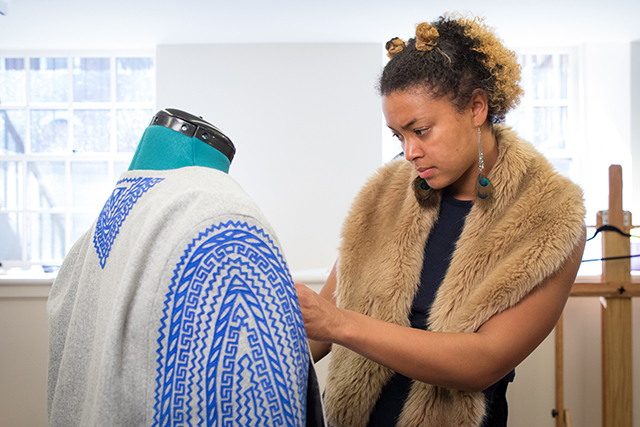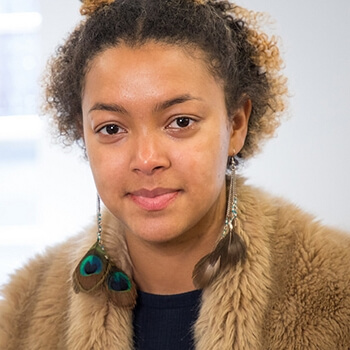Applied math concentration Tallulah Axinn has pursued her interest in fashion at Harvard. (Photo by Eliza Grinnell/SEAS Communications.)
Why did you decide to concentrate in applied math?
I’ve always enjoyed the problem-solving nature of applied math. What excites me about math is that, it might not always be clear what tools you need to find a solution to a problem. I like that I’m able to build from a framework of tools, and then apply them to different areas and solve problems that may not appear to have such a linear approach.
Tell us about the work you’ve done in the lab of Barbara Grosz.
I’ve been working with Barbara Grosz, Higgins Professor of Natural Science, since I took her class, Intelligent Systems: Design and Ethical Challenges (CS 108), in my junior year. Her research is focused on information systems and electronic health record usage. I’ve been focusing on studying, through a usability perspective, how to redesign an electronic health record to be more usable for clinicians, enabling them to extract information easily and retain information that can be lost in a hospital room.

Working with computer science professor Barbara Grosz, Axinn has been researching how to redesign an electronic health record to be more usable for clinicians. (Photo by Eliza Grinnell/SEAS Communications.)
How do you improve the usability of a health record?
Many electronic health record systems are not made to fit in with the doctor’s current workflow, so physicians will end up writing notes by hand or they will omit information from the record. I want to create a system that’s more flexible to be used by clinicians in a very fast-paced environment. For instance, when they are in the room with a patient, they want to be able to easily access information, not spend time looking at their interface or writing down things. I started by reading past usability studies examining the current problems with electronic health records to understand what worked and didn’t work in the existing systems. I then spent time creating prototypes of electronic health record interfaces and talking to doctors to get feedback. I’m hoping that this process, taken from user-centered design, will lead to a system that doctors will want to use. It’s really about making sure that the product you are designing fits the needs of the users by constantly updating the product based on feedback.
What’s the biggest challenge of this work?
The biggest challenge is figuring out which problem to solve. It started from a really big landscape of just understanding the usability problems for the electronic health record. I had to immerse myself in all this literature and then decide which avenue to follow and which research problem to solve.
That work is a bit different from the work you did at Piaggio Fast Forward, a local startup company. Tell us about that experience.
I worked at Piaggio Fast Forward in the summer after my sophomore year in a marketing, operations, and design research role. There were 15 people in the company, and they were in the process of developing their first product, which is a cargo delivery robot. I was doing work with Beth Altringer, Senior Preceptor in Innovation and Design, to think about creating trust in an interaction between a human and a robot. We considered things like the sounds and lights the robot should emit, and the reactions people might have as they physically engage with the robot.
How have you explored your interest in fashion at Harvard?
I did a January-term trip called Designing for Desirability, where each student had a specific focus within the design and fashion world. My focus was on designing for people with disabilities, especially people in wheelchairs. I considered the changing room experience, even the whole process of shopping for clothes, and how jeans should be fitted differently for a user who is constantly seated. I realized that designing for people with disabilities is beneficial to them, but it can also be beneficial to everyone.

Extra-curricular activities, like the student-run IDENTITIES Fashion Show, have enabled Axinn to pursue her interest in fashion at Harvard. (Photo by Eliza Grinnell/SEAS Communications.)
Tell us about your role with the IDENTITIES Fashion Show.
I’ve been grateful for the chance to do something that was just for creativity and expression of art on campus. IDENTITIES is an on-campus, student-run fashion show that sources clothes from designers from around the world. This year, I worked as a creative director and helped choose the clothes that go down the runway. In the last few years, the IDENTITIES Fashion Show has been focusing on innovation in fashion and pushing the boundaries of what people think about when they think about fashion. We’ve had someone from Google present their Project Jacquard, which is a jean jacket that’s connected to a smartphone and could be used by people while they’re commuting. But fashion technology does not have to be crazy—just novel types of thread can make it interesting. This year, I worked with one designer, Carla Fernández, from Mexico City, who works with indigenous communities to preserve their traditional techniques by using the techniques in modern, avant-garde garments. Fernández is just one designer who embodies the spirit of IDENTITIES by showcasing art from different cultures through fashion.
How does your interest in fashion play into your work as a costume designer?
I costume-designed a show called “The Wonderful World of Dissocia.” It was really interesting to work with a director to understand their vision, read the play, and then try to understand what you can convey to the audience through clothing. I think costumes are really important for theater, where it’s this immersive experience and you want to draw people into this world. It was really interesting to connect the ideas of movement and colors and the whole image of what that creates.
What has it been like to be a mentor in Strong Women Strong Girls?
I mentored third- through fifth-grade girls in the Cambridge area, focusing on the theme of strong women throughout history. It was great to develop relationships with these girls at a crucial point in their life, when they are thinking about who they want to be in the world and how they connect with other people. I hope I inspired confidence in them. I think the most important thing is that they are confident enough in their abilities to follow what’s right for them, whether that is STEM, English, or wherever their passions lie.
Why has SEAS been a good fit for you?
SEAS has allowed me to have a very broad experience within engineering, and then also connect to people and different experiences. I’ve been able to have a very interdisciplinary time at SEAS studying applied math, while getting technical skills. But then through my research, which is more focused on design, I’ve been able to connect data and people.
Name: Tallulah Axinn
Concentration: Applied math
Graduation year: 2018
Hometown: San Francisco
Hobbies: Swimming, reading, exploring the city of Boston and trying new restaurants
Fun fact: Tallulah attended a high school in San Francisco where all classes, except English literature, were taught in French.
Tallulah Axinn, A.B. '18
Undergraduate applied mathematics concentrator Talullah Axinn talks about her time at the Harvard John. A. Paulson School of Engineering and Applied Sciences.
Press Contact
Adam Zewe | 617-496-5878 | azewe@seas.harvard.edu
